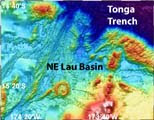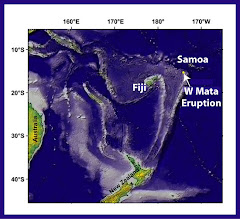Scientists Return to NE Lau Basin, April 28 - May 11, 2010
Backscatter (draped over bathymetry) is semi-transparent to allow bathymetry
to show through. Black represents high backacatter values.
to show through. Black represents high backacatter values.
Background: Elements of Press Release, Dec 17, 2009
Scientists Discover and Image Explosive Deep-Ocean Volcano
Scientists Discover and Image Explosive Deep-Ocean Volcano
During May 2009 scientists funded by NOAA and the National Science Foundation recorded the deepest erupting volcano yet discovered, describing high-definition video of the undersea eruption as “spectacular.” Eruption of the West Mata volcano, discovered in May, occurred nearly 4,000 feet below the surface of the Pacific Ocean, in an area bounded by Fiji, Tonga and Samoa.
Imagery includes large molten lava bubbles approximately three feet across bursting into cold seawater, glowing red vents explosively ejecting lava into the sea, and the first-observed advance of lava flows across the deep-ocean seafloor. Sounds of the explosive eruption were recorded by a hydrophone and later matched to the video footage.
“We found a type of lava never before seen erupting from an active volcano, and for the first time observed molten lava flowing across the deep-ocean seafloor,” said the mission’s Chief Scientist Joseph Resing, a chemical oceanographer at the University of Washington who collaborates with NOAA through the Joint Institute for the Study of the Atmosphere and Ocean. “Though NOAA and partners discovered a much shallower eruption in 2004 in the Mariana Arc, the deeper we get, the closer the eruption is to those that formed most of the oceanic crust.”
“It was an underwater Fourth of July – a spectacular display of fireworks nearly 4,000 feet deep,” said Co-Chief Scientist Bob Embley, a marine geologist based in the Newport, Ore., office of NOAA’s Pacific Marine Environmental Laboratory. “Since the water pressure at that depth suppresses the violence of the volcano’s explosions, we could get the underwater robot within feet of the active eruption. On land, or even in shallow water, you could never hope to get this close and see such great detail,” he said.
Mission scientists released the video and discussed their scientific observations at a Dec. 17 news conference at the American Geophysical Union’s annual fall meeting in San Francisco.
“For the first time we have been able to examine, up close, the way ocean islands and submarine volcanoes are born,” says Barbara Ransom, program director in NSF’s Division of Ocean Sciences. “The unusual primitive compositions of the West Mata eruption lavas have much to tell us.”




